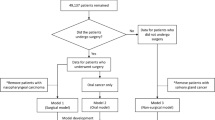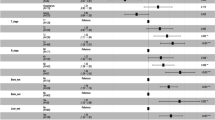Abstract
Background
The objective of this study was to estimate probabilities of cancer-specific death and competing death for patients with head and neck squamous cell carcinoma (HNSCC). In addition, we attempted to construct competing risk nomograms to predict prognosis for patients with HNSCC using a large population-based cohort.
Methods
Patients diagnosed with nonmetastatic HNSCC between 2000 and 2010 were identified from the Surveillance Epidemiology and End Results Program to form the analytic cohort. We estimated cumulative incident function (CIF) of cancer-specific mortality and competing mortality. Nomograms for predicting probability of death were built with proportional subdistribution hazard models.
Results
The study cohort included 23,494 patients with HNSCC. The 5-year CIF for cancer-specific death and competing death were 26.7 % (95 % confidence interval [CI] 26–27.3 %) and 12.7 % (95 % CI 12.2–13.3 %), respectively; 10-year CIF were 32.8 % (95 % CI 31.9–33.6 %) and 23 % (95 % CI 22.1–24 %), respectively. On multivariate analysis, increasing cause-specific mortality was associated with increasing age, increasing tumor size, black race, single status, advanced T and N classifications, and high tumor grade. Increasing probability of competing mortality had a relationship with increasing age, male, black race, single status and nonradiotherapy. Models showed good accuracy with c-index of 0.73 for cause-specific mortality model and 0.69 for competing mortality model.
Conclusions
We constructed competing risk nomograms for HNSCC using population-based data. The model used for building nomograms represented good performance. These nomograms can serve to guide management of patients with HNSCC.



Similar content being viewed by others
References
Ferlay J, Shin HR, Bray F, Forman D, Mathers C, Parkin DM. Estimates of worldwide burden of cancer in 2008: GLOBOCAN 2008. Int J Cancer. 2010;127(12):2893–917.
Siegel R, Naishadham D, Jemal A. Cancer statistics, 2013. CA: Cancer J Clin. 2013;63(1):11–30.
Kuperman DI, Auethavekiat V, Adkins DR, et al. Squamous cell cancer of the head and neck with distant metastasis at presentation. Head Neck. 2011;33(5):714–8.
Surveillance, Epidemiology, and End Results (SEER) Program (www.seer.cancer.gov) SEER*Stat Database: Incidence - SEER 9 Regs Research Data, Nov 2011 Sub (1973-2010) <Katrina/Rita Population Adjustment>- Linked To County Attributes - Total U.S., 1969–2010 Counties, National Cancer Institute, DCCPS, Surveillance Research Program, Surveillance Systems Branch, released April 2013, based on the November 2012 submission.
Argiris A, Brockstein BE, Haraf DJ, et al. Competing causes of death and second primary tumors in patients with locoregionally advanced head and neck cancer treated with chemoradiotherapy. Clin Cancer Res. 2004;10(6):1956–62.
Adelstein DJ, Li Y, Adams GL, et al. An intergroup phase III comparison of standard radiation therapy and two schedules of concurrent chemoradiotherapy in patients with unresectable squamous cell head and neck cancer. J Clin Oncol. 2003;21(1):92–8.
Mell LK, Dignam JJ, Salama JK, et al. Predictors of competing mortality in advanced head and neck cancer. J Clin Oncol. 2010;28(1):15–20.
Gray RJ. A class of k-sample tests for comparing the cumulative incidence of a competing risk. Ann Stat. 1988;16:1141–54.
Fine JP, Gray RJ. A proportional hazards model for the subdistribution of competing risks in survival analysis. J Am Stat Assoc. 1999;94:496–509.
Harrell FE. Regression modeling strategies: With applications to linear models, logistic regression, and survival analysis. New York: Springer; 2001.
Kattan MW, Heller G, Brennan MF. A competing-risks nomogram for sarcoma-specific death following local recurrence. Stat Med. 2003;22(22):3515–25.
Kalbfleisch JD, Prentice RL. The statistical analysis of failure time data. Hoboken, New Jersey: Wiley & Sons, Inc.; 1980.
R Core Team (2013). R: A language and environment for statistical computing. R Foundation for Statistical Computing, Vienna, Austria. URL http://www.R-project.org/.
Frank E Harrell Jr < f.harrell@vanderbilt.edu > (2011). rms: Regression modeling strategies. R package version 3.3-1. http://CRAN.R-project.org/package=rms.
Bob Gray < gray@jimmy.harvard.edu > (2011). cmprsk: Subdistribution analysis of competing risks. R package version 2.2-2. http://CRAN.R-project.org/package=cmprsk.
Wolbers M, Koller MT, Witteman JC, Steyerberg EW. Prognostic models with competing risks: methods and application to coronary risk prediction. Epidemiology. 2009;20(4):555–61.
Pintilie M. Competing risks: a practical perspective. Chichester, West Sussex, England: John Wiley & Sons Ltd.; 2006.
Hinchliffe SR, Lambert PC. Flexible parametric modelling of cause-specific hazards to estimate cumulative incidence functions. BMC Med Res Methodol. 2013;13:13.
Yang L, Shen W, Sakamoto N. Population-based study evaluating and predicting the probability of death resulting from thyroid cancer and other causes among patients with thyroid cancer. J Clin Oncol. 2013;31(4):468–74.
Rose BS, Jeong JH, Nath SK, Lu SM, Mell LK. Population-based study of competing mortality in head and neck cancer. J Clin Oncol. 2011;29(26):3503–9.
Iasonos A, Schrag D, Raj GV, Panageas KS. How to build and interpret a nomogram for cancer prognosis. J Clin Oncol. 2008;26(8):1364–70.
Hanrahan EO, Gonzalez-Angulo AM, Giordano SH, et al. Overall survival and cause-specific mortality of patients with stage T1a,bN0M0 breast carcinoma. J Clin Oncol. 2007;25(31):4952–60.
Porter CR, Suardi N, Capitanio U, et al. A nomogram predicting prostate cancer-specific mortality after radical prostatectomy. Urol Int. 2010;84(2):132–40.
Stephenson AJ, Kattan MW, Eastham JA, et al. Prostate cancer-specific mortality after radical prostatectomy for patients treated in the prostate-specific antigen era. J Clin Oncol. 2009;27(26):4300–5.
Kutikov A, Egleston BL, Wong YN, Uzzo RG. Evaluating overall survival and competing risks of death in patients with localized renal cell carcinoma using a comprehensive nomogram. J Clin Oncol. Jan 10 2010;28(2):311–7.
Pathak KA, Mazurat A, Lambert P, Klonisch T, Nason RW. Prognostic nomograms to predict oncological outcome of thyroid cancers. J Clin Endocrinol Metab. 2013;98(12):4768–75.
Kutikov A, Cooperberg MR, Paciorek AT, Uzzo RG, Carroll PR, Boorjian SA. Evaluating prostate cancer mortality and competing risks of death in patients with localized prostate cancer using a comprehensive nomogram. Prostate Cancer Prostatic Dis. 2012;15(4):374–9.
Montero PH, Yu C, Palmer FL, et al. Nomograms for preoperative prediction of prognosis in patients with oral cavity squamous cell carcinoma. Cancer. 2014;120(2):214–21.
Ali S, Palmer FL, Yu C, et al. Postoperative nomograms predictive of survival after surgical management of malignant tumors of the major salivary glands. Ann Surg Oncol. 2014;21(2):637–42.
Du XL, Fox EE, Lai D. Competing causes of death for women with breast cancer and change over time from 1975 to 2003. Am J Clin Oncol. 2008;31(2):105–16.
Kircher T, Nelson J, Burdo H. The autopsy as a measure of accuracy of the death certificate. N Engl J Med. 1985;313(20):1263–9.
Lughezzani G, Sun M, Shariat SF, et al. A population-based competing-risks analysis of the survival of patients treated with radical cystectomy for bladder cancer. Cancer. 2011;117(1):103–9.
Beyersmann J, Schumacher M, Allignol A. Competing risks and multistate Models with R (Use R!). New York, NY: Springer Science + Business Media; 2012.
Steyerberg EW. Clinical prediction models: a practical approach to development, validation, and updating. New York: Springer; 2009.
Acknowledgment
The authors thank Dr. Wolbers for providing guidance in calculating the c-index. The authors also thank SEER for open access to their database.
Disclosure
None.
Author information
Authors and Affiliations
Corresponding author
Additional information
Weidong Shen and Limin Yang have contributed equally to this work.
Rights and permissions
About this article
Cite this article
Shen, W., Sakamoto, N. & Yang, L. Cancer-Specific Mortality and Competing Mortality in Patients with Head and Neck Squamous Cell Carcinoma: A Competing Risk Analysis. Ann Surg Oncol 22, 264–271 (2015). https://doi.org/10.1245/s10434-014-3951-8
Received:
Published:
Issue Date:
DOI: https://doi.org/10.1245/s10434-014-3951-8




